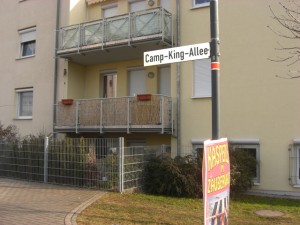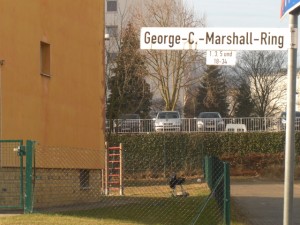A stateside reader of my post Zum Fuchstanz near Oberursel/Feldberg wrote that he had been living in Camp King in the 60s and was interested in its progress. And as I live so close to this former military camp – I can see it from my kitchen window – I sometimes tend to forget its historical significance.
Back in the 1960s, only fields and meadows separated the northern end of the camp from the Feldberg mountain. On those same fields, the German development “Im Rosengärtchen” was constructed in 1972, and this is where I am sitting and writing this post while facing the Feldberg mountain on this overcast day.
To revisit Camp King’s history, I took another walk through the area to take some photos.

One of the two buildings left on the northern end of the camp, which is facing the Feldberg mountain.

The extended yard has been replaced by a narrow parking strip. Gone are the old trees!

U.S. housing had been built away from the main road (Hohemarkstrasse), but now the space has been filled in by a commercial building.

Connecting the old with the new… I walk through this passage on my way to the super market.

Looking from the northern end building onto what used to be farmers’ fields. Note: the big yard still is there, which must be the envy of the German neighbors with their Lilliputian plots.

Walking towards the end of the camp where the administrative buildings and officers’ housing used to be.

A bit of nature remains for summer outings.

Yet unrestored half-timbered building up on the hill.

Old and new mixed in Camp King

The camp was named after Colonel Charles B. King on 19.09.1946.

The former basketball gym’s wooden floor was turned into a woodcarving and preserved by Thomas Kilpper, whose artwork tells the history of the camp. He titled it “Don’t Look Back”.
To learn more about Oberursel and its Camp King history, visit Oberursel Today or you might like to join me on a walk through Camp King via podcast.






